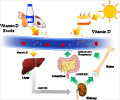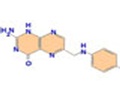Highlights
- Estrogen disruptor chemicals (EDCs) are found in cosmetics, food packaging and children’s toys.
- Exposure to EDCs is associated with lower levels of vitamin D.
- Women are found to have a more pronounced effect than men.
Endocrine Disruptors
Endocrine disruptors are chemicals that affect the endocrine system of the body, leading to- Developmental
- Neurological
- Reproductive
- Immune effects of the body
EDC Exposure and Vitamin D Levels
The study included 4667 adults who were part of the National Health and Nutrition Examination Survey (NHANES) which was conducted during the period 2005 and 2010. Blood and urine samples of the study participants were analyzed, the blood samples were used to detect the level of vitamin D while the urine samples were used to detect the concentration of EDC.The study found that
- Increased in concentration of phthalates resulted in lower levels of vitamin D
- Women were found to be more affected by phthalate levels than men
- Increased concentration of Bisphenol A in the blood resulted in lower levels of vitamin D, especially in women
Sources of Endocrine Disruptors
EDCs include
- Pharmaceuticals
- Polychlorinated biphenyls
- Pesticides
- Dioxin and dioxin like compounds
- Bisphenol A
- Food packaging
- Medical tubes
- Cosmetics
- Children’s toys
- Over stimulation of hormones: EDCs mimic hormones and lead to overstimulation.
- Binding to receptors: EDCs bind to target receptors and prevent attachment of the hormone.
Vitamin D is essential for proper bone growth and development in the body.
- Poor bone development.
- Development of rickets (softening or weakening of bones in children) or osteomalacia.
- Poor bone density.
- Increased risk for fracture.
- In the NHANES II study, it was found that the risk of death was lower by 45% when vitamin D levels were above 45ng/mL.
- Increased risk for cancer.
- Increased risk of infection.
- Increased risk for mental illness.
- Endocrine Disruptors - (http://www.niehs.nih.gov/health/topics/agents/endocrine/)
- The Estrogenic Endocrine Disrupting Chemical Bisphenol A (BPA) And Obesity - (http://www.ncbi.nlm.nih.gov/pmc/articles/PMC3306519/)
- Vitamin D Insufficiency - (http://www.ncbi.nlm.nih.gov/pmc/articles/PMC3012634/)
















